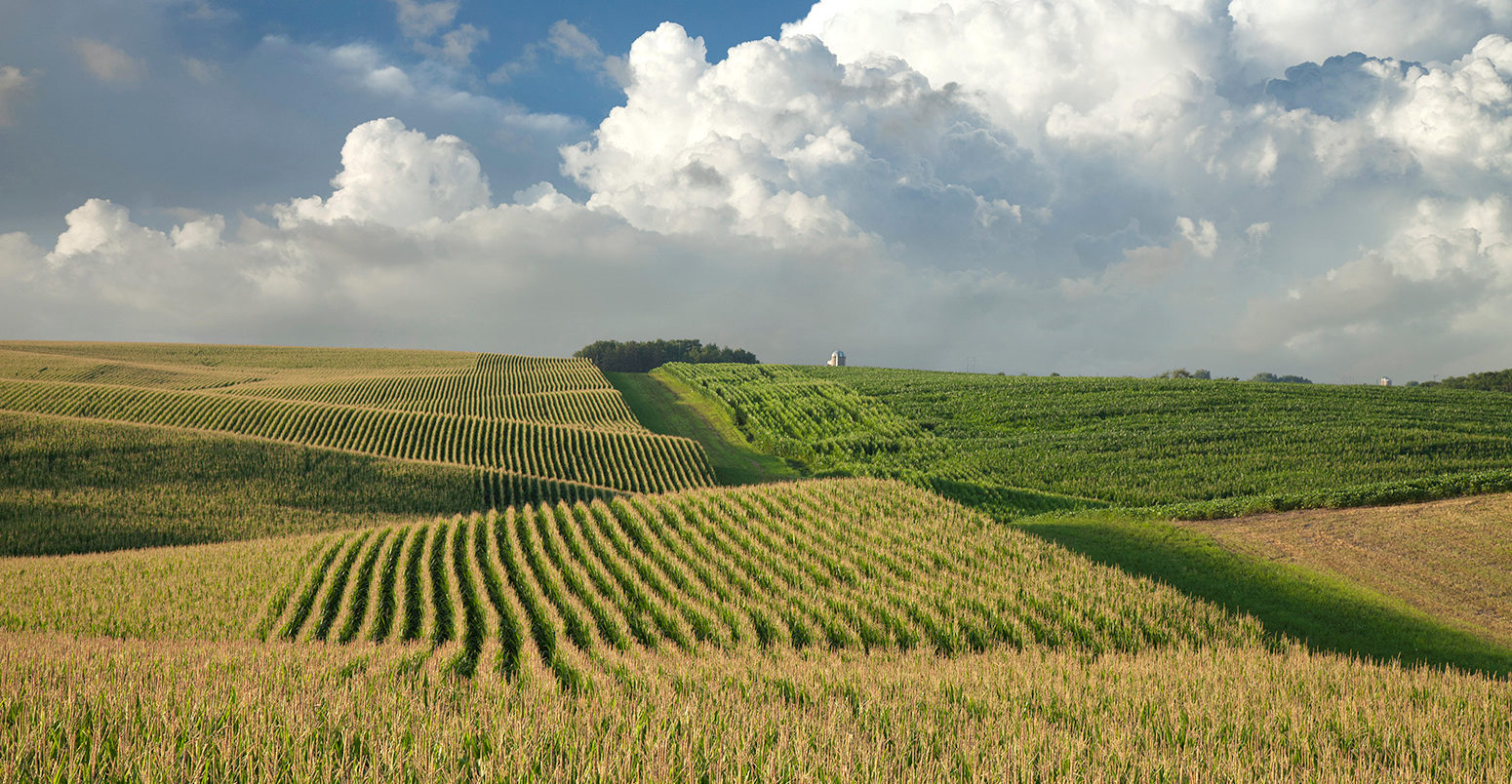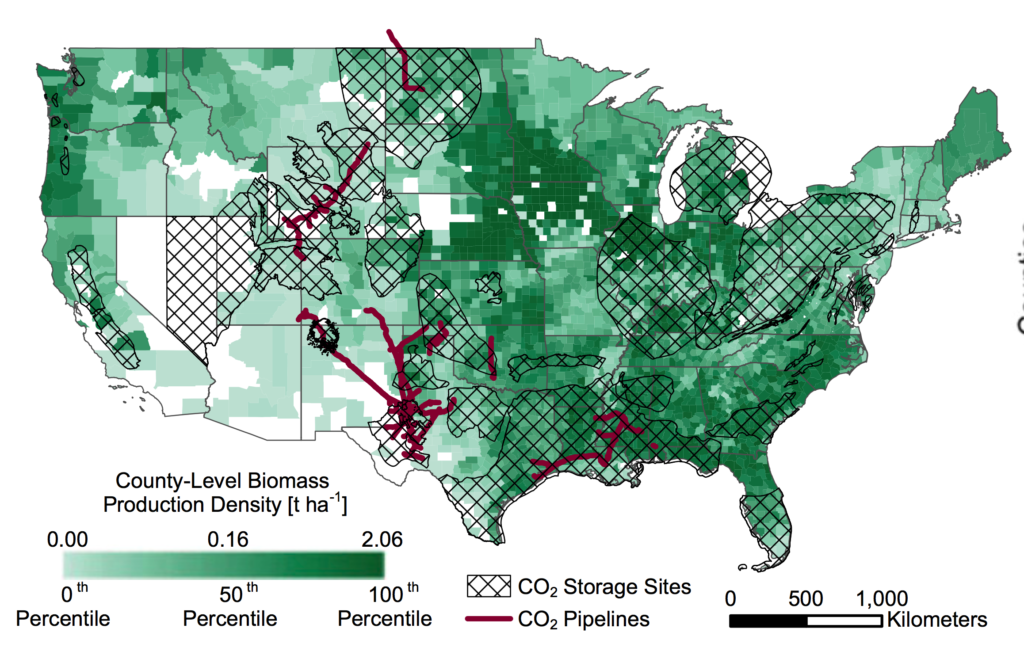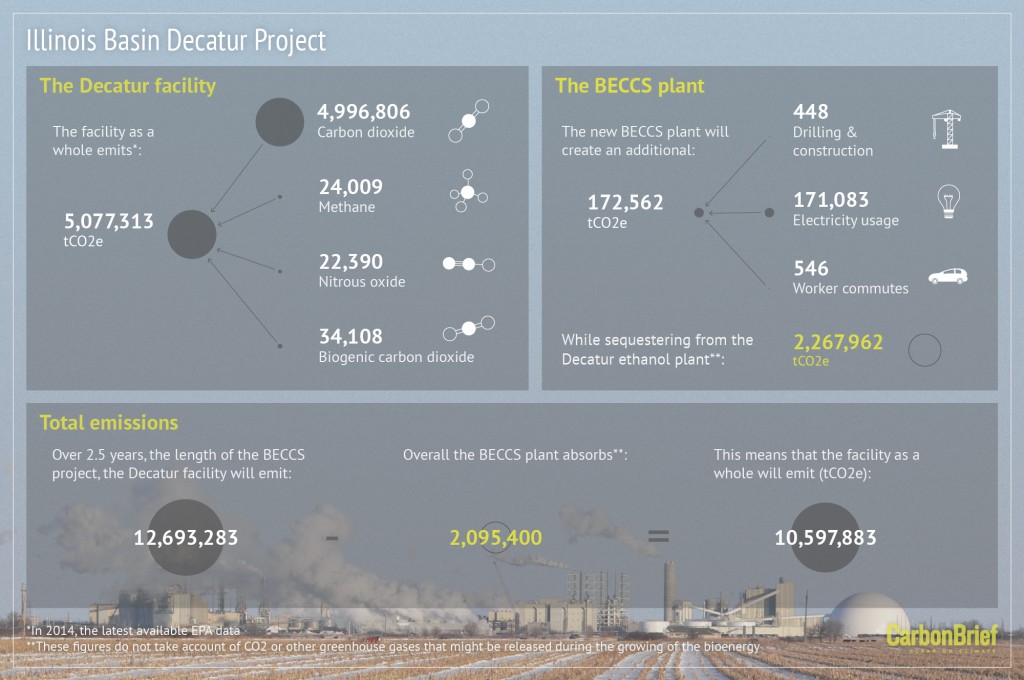
New maps pinpoint the potential for BECCS across the US
Zeke Hausfather
03.12.18Zeke Hausfather
12.03.2018 | 7:01pmModels developed to explore how the world might limit future warming to the “well below 2C” target of the Paris Agreement on climate change typically employ large amounts of “negative emissions” later in the century.
The majority of these “energy system” models employ a technology called bioenergy with carbon capture and storage (BECCS) at a massive scale. BECCS involves growing plants, absorbing CO2 in the process, then converting the resulting biomass into energy. The carbon emissions are captured and buried underground, both removing CO2 the atmosphere and producing energy at the same time.
But the areas where large volumes of biomass can be grown and CO2 can be stored do not necessarily overlap. A new study, published in the Proceedings of the National Academy of Sciences (PNAS), examines the areas of the US that might fit both criteria – and whether BECCS can be implemented at the scale assumed in the energy models.
The researchers find that there are enough suitable areas of the US to remove around 110m-120m tonnes (Mt) CO2 from the atmosphere by 2020 and 360-630MtCO2 by 2040.
This is similar to what energy models assume will be deployed across the US in a world where warming is limited to well below 2C.
Models rely on BECCS
There is relatively little “carbon budget” left to limit the world to 1.5C or 2C above pre-industrial levels. At the current rate of global CO2 emissions, a 1.5C budget will be exhausted in less than 10 years, while a 2C budget will be exhausted in less than 20.
Few energy system modellers expect that the world could move fast enough to completely eliminate all CO2 emissions globally that quickly, so to meet these targets and minimize expected costs they model a more gradual decline in emissions followed by “net-negative” emissions later in the century, where carbon is removed from the atmosphere and stored indefinitely.
The measure most commonly employed in models to achieve net-negative emissions is BECCS, because it not only sequesters CO2, but also produces energy. Models simulating pathways to limiting global warming to 1.5C or 2C scenarios see negative emissions by the end of the century removing an amount equivalent to half or more of current global emissions, or roughly 20,000MtCO2 per year..
![]()
The US is of particular interest for the initial development and deployment of BECCS because it has relatively high biomass productivity and well-mapped geologic storage sites for CO2. The US also has a relatively mature bioenergy industry, as well as a number of pilot scale CO2 injection projects – though some of these have proven more successful than others.
The figure below shows what eight different integrated assessment models (IAMs) suggest for BECCS use in the US under a future 2C scenario. There is a wide range of possible future BECCS deployment, from zero to 1100MtCO2 in 2050 and 800-7500MtCO2 in 2100 – though most models suggest that BECCS will be under 3000MtCO2 or so at the end of the century. For reference, current US CO2 emissions are a bit above 5000MtCO2.
Estimated US BECCS deployment across eight different IAMs included in the 2014 AMPERE modelling project results. More recent modelling projects, such as the RCP or SSP databases, lack publically available country-specific values. Data from the IIASA AMPERE database; chart by Carbon Brief using Highcharts.Their models simulate no large-scale deployment of BECCS in the US until around 2020, between zero and 160MtCO2 negative emissions by 2030, and zero to 790MtCO2 in 2040.
The new study looks to see how technically viable these modelled projections are in the US in the 2020 and 2040 periods, based on a detailed analysis of both the availability of biomass and reservoirs for CO2 storage.
Mapping biomass availability
The US Department of Energy (DOE) estimates that around 220m tonnes of biomass could be available each year for use by 2020. Around 50% of this biomass would come from agricultural residues, 40% from a combination of offcuts from logging and trees harvested specifically for biomass, with the remaining 10% from crops grown specifically for bioenergy. This means that, in the short term at least, there would be limited displacement of crop land for bioenergy as much of it could come from waste sources.
The figure below shows both the expected location of available biomass for use in bioenergy (green shading) and the location of suitable geologic storage for CO2 (cross-hatching) in 2020.
Around 37% of all available biomass is found in the midwestern Corn Belt, where around 89% of it is agricultural residue. Energy crops are concentrated in the Southern Plains. Woody biomass is concentrated in the Southeast, Pacific West and Appalachian regions.

Projected 2020 biomass production (green) from the US DOE and potential CO2 storage sites (black crosshatches) from the USGS. Existing CO2 pipelines are included in red. Adapted from Figure 1 in Baik et al. (2018)
If all of the biomass available in 2020 were used for BECCS, it could, in theory, provide 370-400MtCO2 per year. However, not all of it is located near a suitable site for storing the captured CO2.
While the US has a huge CO2 storage potential, with a total storage capacity estimated at around 3,000,000MtCO2. These storage sites are concentrated in the Southern, Northeastern, and Central Western parts of the country.
However, there are relatively few pipelines in place for transporting CO2 and the long-distance transportation of large volumes of captured CO2 may prove prohibitively expensive, particularly if many small pipelines have to be built. New pipelines in the past have engendered significant local opposition, resulting in project delays an higher costs.
Biomass could be transported to sites where CO2 storage is available, but biomass tends to have a lot of weight relative to its energy content, much more than for traditional fossil fuels. Transporting large amounts of biomass long distances would significantly add to the cost of BECCS.
Until a large scale CO2 pipeline network or biomass transportation infrastructure is available, the new study suggests that BECCS will have to be limited to sites where biomass and suitable CO2 storage are both available.
Sites close to geologic storage
The figure below shows the areas where both biomass can be effectively produced and CO2 can be injected and stored across the US.
The study finds that about a third of the total potential biomass in 2020 is located close enough to geologic storage. However, much of the Midwest corn belt in the central northern part of the country, which produces large amounts of crop residue, is too far from geologic storage to be a viable location for BECCS in the near-term.

CO2 potential from biomass in 2020 in areas collocated with geologic storage (left) and cumulative potential by country in 2020 and 2040 (right). Taken from Figure 2 in Baik et al. (2018)
The authors estimate that the potential for BECCS in the US by 2020 at around 110-120MtCO2 per year. Approximately 41% would be from agricultural residue, 44% from woody biomass and 16% from energy crops. (If proximity to geologic storage was not a limiting factor, you would expect to see more biofuel from residues and less from energy crops.)
They found that the northern Illinois basin, the US Gulf region, and western North Dakota are the most promising areas for near-term BECCS deployment. The Gulf region, in particular, would be a suitable location for BECCS due to existing pipeline infrastructure, experience with CO2 injection into geologic formations and good data on potential storage sites as a result of past oil and gas exploration.
There is already a pilot BECCS plant in Decatur, Illinois, run by Archer Daniels Midland (ADM) that captures CO2 released by fermenting corn and injects it into the layer of sandstone that lies underneath the city. ADM’s ethanol plant is capturing and storing more than one million tonnes of CO2 per year, or about 1% of the US potential for 2020 estimated in the study.
The study also examined the rate at which CO2 could be injected into wells at different geologic storage sites. They found that in nearly all areas, a single well would be sufficient to inject all the CO2 available from biomass. In the 1% of counties where this is not the case, CO2 injection would be possible with multiple wells, but it would increase costs.
If the analysis is extended out through 2040, the economically available biomass increases significantly, from around 320Mt to up to 1000Mt. This is due to the assumed larger-scale economic viability by 2040 of crops grown specifically for use in producing energy. These would increase to around 70% of all available biomass in 2040, from around 10% in 2020. This translates to potential BECCS of around 1040-1780MtCO2 per year, with 360-630MtCO2 of that close to a geologic storage site.
Technically feasible
The study finds that the US has a sizable potential for BECCS that is suitably close to geologic CO2 storage. The potential amounts of BECCS are close to the values assumed for the US in integrated assessment models, suggesting that the modelled deployment of BECCS in the US is at least technically feasible.
As the study’s lead author, Ejeong Baik of Stanford University, tells Carbon Brief:
“Establishing BECCS projects in areas with co-located biomass and storage sites may not necessarily be the best locations when optimising for largescale BECCS infrastructure that incorporate more biomass and extensive transportation networks. However, developing the low-cost opportunities is a great way to jumpstart deployment and can help bring down costs for future projects. Early development of BECCS can also help establish market structures that will later support large-scale deployment of BECCS.”
Despite these findings, BECCS will still face a number of hurdles to reach its potential.
While enough bioenergy is located near geologic storage to meet modelled 2040 BECCS, models assume that the use of BECCS ramps up considerably from there through to the end of the century. This suggests that there is still a need for transportation systems for either biomass or CO2 “for deployment of BECCS at the scale of several hundred megatonnes of CO2 per year in the US”, with co-located sites alone insufficient for a very large scale use of BECCS.
There are also large uncertainties about the long-term economic viability of BECCS not addressed in this study, as well as the land, water and fertiliser that would be required at the scale suggested for the end of the century. Other negative emissions technologies not included in the IAMs may also play a role, potentially reducing the amount of BECCS needed in the future to meet a target of limiting warming to well below 2C above pre-industrial levels while minimizing costs to society.
Updated on 13/03/2018: The article has been edited to clarify that BECCS are not “required” by IAMs per se, but rather are generally preferred because they are assumed to be part of the lowest-cost option to meet a “well below 2C” target in the models. Similarly, not all BECCS are used to generate electricity. Models project that roughly half of BECCS will be used for non-electricity purposes by 2050, mostly biofuel (fermentation) with CCS.
Baik, E. et al. (2018) Geospatial analysis of near-term potential for carbon-negative bioenergy in the United States, Proceedings of the National Academy of Sciences, doi:10.1073/pnas.1720338115


